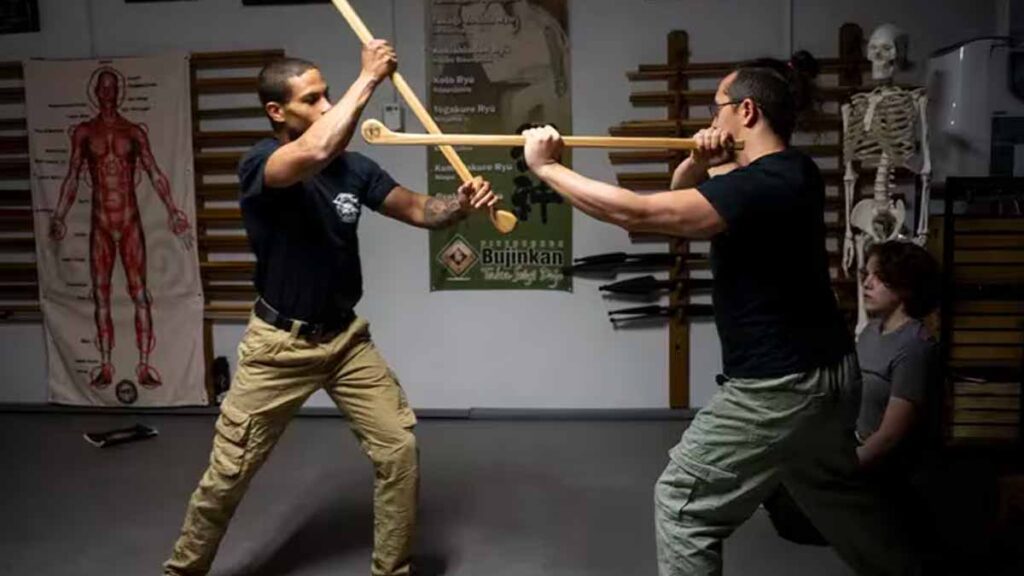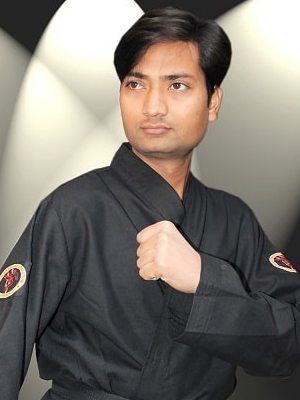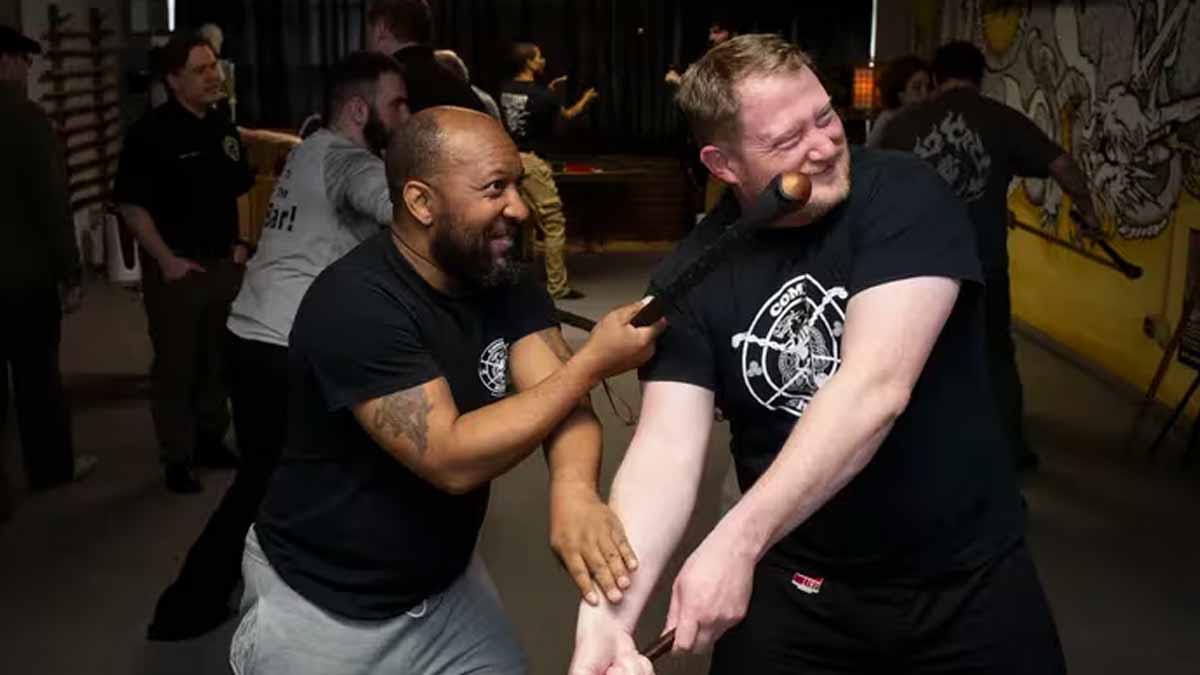In the twentieth century, Irish shillelagh fighting was all but forgotten.
On March 2, 2024, John Cheatwood, aged 45, from Pittsburgh, Pennsylvania, on the left, engages in combat techniques with Ross Lungren, aged 41, also from Pittsburgh, during a Combat Shillelagh class at the Pittsburgh Bujinkan Dojo.
The Irish Shillelagh Fighting
It’s possible that somewhere out there, a shirt bears an off-color joke about “Irish karate.” However, on a misty and gray Saturday morning in March, within the confines of the martial arts dojo, there was no one doubling over in laughter or donning green attire.
In the heart of the city’s East End, Bujinkan Dojo, nestled within a converted tile factory, exuded an ambiance steeped in ancient Japanese tradition. Adornments of sharp throwing stars adorned the walls, alongside tapestries depicting samurai warriors.
A striking centerpiece was a large, meticulously hand-painted re-creation of the “crying dragon,” reminiscent of a memorable encounter experienced by members during their visit to a Buddhist temple located approximately 65 miles west of Tokyo.
“The Irish Shillelagh Fighting,” However, on the training mat, a group of about twelve individuals were handling slender, knotted wooden implements, reminiscent of the sort of stick one might envision a hobbling leprechaun wielding. This marked the entrance into the realm of Combat Shillelagh.
“Instructor Brian Fine cautioned his students, ‘Don’t just stand there, or you might end up getting hit in the head,'” relayed the instructor to his attentive pupils.
Irish Shillelagh Fighting boast a history spanning over 1,000 years, originating from the village of the same name in County Wicklow. Traditionally crafted from the sturdy yet pliable roots and root balls of the blackthorn shrub, these implements served various purposes.
Thinner shillelaghs doubled as walking sticks and tools for self-defense, while thicker, weightier variants, often referred to as clubs or cudgels, were wielded for more aggressive purposes—think along the lines of Walter “Monk” McGinn from “Gangs of New York.”
Today, the Irish Shillelagh Fighting often serves as a vibrant symbol of Irish heritage, with even the Boston Celtics emblematically depicted leaning on one. Yet, according to Brent Earlewine, the owner of the dojo and founder of Combat Shillelagh, it carries deeper connotations of pride and defiance.
Earlewine, aged 55, elaborated, “Certainly, it started as a simple walking stick or a means to ward off wild dogs. However, during the era when Irish peasants endured English rule and faced a ban on weapons, it took on a greater significance. It became a surrogate, a symbol of resistance against oppression. In essence, it offered a clandestine means to practice swordsmanship, using a humble stick as a covert tool.”

Earlewine, a resident of Pittsburgh with a background in the tech industry, pointed out that traditional martial arts from Eastern cultures such as Japan, Korea, and China have been meticulously preserved and extensively documented over the centuries. This rich history explains the widespread presence of thousands of martial arts dojos across the United States.
However, many facets of Irish heritage, including the Gaelic language, faced prohibition during British rule. The devastating famine that engulfed the island, coupled with the ensuing mass emigration, resulted in the loss of millions of lives and forced countless Irish individuals to seek refuge in distant lands with little more than the clothes on their backs.
According to Earlewine, while Ireland had its own unique forms of martial arts, such as specific boxing techniques and collar-and-elbow wrestling, certain practices like stick fighting, known as bataireacht, had largely vanished by the 19th century.
“That knowledge was primarily transmitted through oral tradition, and for a time, it was lost,” he remarked.
Daniel Kanagie, hailing from Philadelphia and instructing in traditional bare-knuckle fighting under the banner of Wolfhound Martial Arts, developed an interest in older Western martial arts after observing swordsmanship displays at the Pennsylvania Renaissance Fair in 2001.
“Every nation, every culture has faced threats and found the need to defend itself, leading to the development of unique methods, including in Ireland,” he explained.
Kanagie highlighted the prevalence of large-scale conflicts between families or communities in Ireland, commonly referred to as “faction fights,” where shillelaghs, brass knuckles, stones, and various other implements of violence would have been wielded. He noted that remnants of such practices carried over to the United States, as depicted in films like “Gangs of New York.”
“They’re called the ‘fighting Irish’ for a reason,” Kanagie said.
In Pittsburgh, Earline embarked on formal Irish Shillelagh Fighting training in 2016 and initiated courses in 2019. His teaching endeavors have extended to both in-person sessions at the dojo, online instruction, and, later this month, he will be journeying to Ireland to conduct shillelagh classes in County Wicklow. During this trip, he plans to visit a fifth-generation shillelagh maker.
“I have students in 40 states and 25 countries, so it’s really gaining momentum,” he expressed. “There’s also a noticeable resurgence happening in Ireland.”
The majority of Earlewine’s initial students, including Fine, have transitioned into instructors themselves. Fine, who originally had a background in firearms, sought out alternatives for self-defense.
“I was searching for something outside the realm of sports,” he explained.
For instructor Nick Carrington, adorned in an Irish sweater and a newsboy cap, the Irish Shillelagh Fighting has become a fervent passion.
“Once I held a shillelagh in my hands, it felt like a revelation,” he remarked.
The stick fighting techniques seem to revolve around strategic angles, with practitioners moving forward and backward to evade incoming strikes while delivering their own. Utilizing the stick for both blocking and striking, even a minor misstep could result in the shillelagh’s club making contact with sensitive areas like ribs, inner thighs, or knuckles.
These techniques are practiced at a slower pace in the dojo, as engaging in live combat would necessitate protective gear like helmets and thick gloves, with the high likelihood of injuries and bloodshed.
“We’re practicing at a slower pace to train your mind,” Earlewine explained. “If we move too quickly, you might miss your target and get hit.”
According to Earlewine, many of the shillelagh techniques can be adapted for use with an average wooden cane or even a “tactical” umbrella. Tactical versions of various everyday items, such as pens and expensive flashlights, exist, and Bujinkan Dojo offers self-defense classes incorporating these tools.
While carrying a shillelagh as a walking stick is generally accepted, bringing one onto a plane or into a Steelers game may be subject to individual circumstances, with a doctor’s note often helpful.
Among Earlewine’s students on this Saturday morning was John Cheatwood III, a 44-year-old resident of Pittsburgh. Having trained in traditional Japanese styles at the dojo for years, he joined the shillelagh class to enhance his skills further.
As a teacher and someone smaller in stature compared to most of his friends, Cheatwood expressed his desire to be capable of defending himself in case of trouble outside and to be of assistance in potential school-related incidents.
Cheatwood, aged 44, discovered through DNA testing that he has Scottish and English ancestry alongside his Nigerian heritage, likely stemming from his family’s history of slavery.
“That’s another aspect of my identity I’m learning about,” he reflected. “And I guess this is part of it too.”
Click here to know What is Kassido Martial Art ?

Martial arts trainer Karatians School India, Thank you for reading this post. This website is about martial arts, sports, and entertainment. Its goal is to make more people aware of martial arts and help them become self-reliant.

